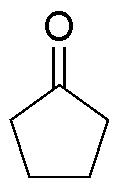Cyclopentan-1-one is widely utilized in research focused on:
- Flavor and Fragrance Industry: This compound is used as a key ingredient in creating various flavorings and fragrances, providing a unique scent profile that enhances consumer products.
- Synthesis of Pharmaceuticals: Cyclopentan-1-one serves as an important intermediate in the synthesis of various pharmaceuticals, offering a versatile building block for drug development.
- Polymer Production: It is utilized in the production of certain polymers, contributing to materials with desirable properties such as flexibility and durability.
- Research in Organic Chemistry: This compound is often used in organic synthesis reactions, allowing researchers to explore new chemical pathways and develop innovative compounds.
- Solvent Applications: Cyclopentan-1-one acts as a solvent in various chemical processes, providing an effective medium for reactions while enhancing product yield.
General Information
Properties
Safety and Regulations
Applications
Cyclopentan-1-one is widely utilized in research focused on:
- Flavor and Fragrance Industry: This compound is used as a key ingredient in creating various flavorings and fragrances, providing a unique scent profile that enhances consumer products.
- Synthesis of Pharmaceuticals: Cyclopentan-1-one serves as an important intermediate in the synthesis of various pharmaceuticals, offering a versatile building block for drug development.
- Polymer Production: It is utilized in the production of certain polymers, contributing to materials with desirable properties such as flexibility and durability.
- Research in Organic Chemistry: This compound is often used in organic synthesis reactions, allowing researchers to explore new chemical pathways and develop innovative compounds.
- Solvent Applications: Cyclopentan-1-one acts as a solvent in various chemical processes, providing an effective medium for reactions while enhancing product yield.
Documents
Safety Data Sheets (SDS)
The SDS provides comprehensive safety information on handling, storage, and disposal of the product.
Product Specification (PS)
The PS provides a comprehensive breakdown of the product’s properties, including chemical composition, physical state, purity, and storage requirements. It also details acceptable quality ranges and the product's intended applications.
Certificates of Analysis (COA)
Search for Certificates of Analysis (COA) by entering the products Lot Number. Lot and Batch Numbers can be found on a product’s label following the words ‘Lot’ or ‘Batch’.
*Catalog Number
*Lot Number
Certificates Of Origin (COO)
This COO confirms the country where the product was manufactured, and also details the materials and components used in it and whether it is derived from natural, synthetic, or other specific sources. This certificate may be required for customs, trade, and regulatory compliance.
*Catalog Number
*Lot Number
Safety Data Sheets (SDS)
The SDS provides comprehensive safety information on handling, storage, and disposal of the product.
DownloadProduct Specification (PS)
The PS provides a comprehensive breakdown of the product’s properties, including chemical composition, physical state, purity, and storage requirements. It also details acceptable quality ranges and the product's intended applications.
DownloadCertificates of Analysis (COA)
Search for Certificates of Analysis (COA) by entering the products Lot Number. Lot and Batch Numbers can be found on a product’s label following the words ‘Lot’ or ‘Batch’.
*Catalog Number
*Lot Number
Certificates Of Origin (COO)
This COO confirms the country where the product was manufactured, and also details the materials and components used in it and whether it is derived from natural, synthetic, or other specific sources. This certificate may be required for customs, trade, and regulatory compliance.


